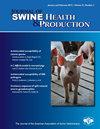断奶仔猪饲粮中添加铜对铁处理仔猪生长性能和血液学特性的影响
IF 0.7
4区 农林科学
Q3 Agricultural and Biological Sciences
引用次数: 4
摘要
目的:探讨饲粮铜对断奶铁仔猪生长发育的影响。材料与方法:144头断奶仔猪被分配到2 × 2 × 2因子处理组(6个猪圈/处理,3头猪/猪圈)。影响因素包括体型(大或小)、100毫克肌内铁剂量(出生或出生和断奶)和膳食铜(14.2或250 ppm)。试验49 d,测定平均日增重(ADG)、采食量(ADFI)和料重比。分别于断奶、第7天和第49天采血。结果:大型猪断奶时血红蛋白(P < 0.001)和红细胞压积(P = 0.002)较低。接受两剂量铁的猪有更高的血红蛋白(P = 0.05)和红细胞压积(P = 0.04)。对照组饲粮的血红蛋白(P = .03)和红细胞压积(P = .03)高于对照组。仅在大型猪中,接受两剂铁的个体在第49天的体重更大(P = 0.05)。在整个试验中,铁剂量与饲料之间的相互作用影响了许多生长指标,包括平均日增重(P = 0.02)和平均日增重(P = 0.04)。在所有情况下,接受两剂铁的铜饲猪的生产性能都更好。含义:断奶时,较大的猪具有与较低铁状态一致的血液学特征。断奶时铁处理增加血红蛋白。只有在断奶时接受铁的情况下,铜才能促进猪的生长。在铜饲猪中,血红蛋白较少,可能表明对铁的吸收有负面影响。本文章由计算机程序翻译,如有差异,请以英文原文为准。
Growth performance and hematology characteristics in pigs treated with iron at weaning as influenced by nursery diets supplemented with copper
Objective: Determine the effects of dietary copper on growth in pigs given iron at weaning. Materials and methods: Weanlings (n = 144) were allocated to a 2 × 2 × 2 factorial arrangement of treatments (6 pens/treatment, 3 pigs/pen). Factors were size (large or small), 100 mg intramuscular iron doses (birth or birth and weaning), and dietary copper (14.2 or 250 ppm). Average daily gain (ADG), feed intake (ADFI), and gain to feed ratio were determined for 49 days. Blood was sampled at weaning and days 7 and 49. Results: Hemoglobin (P < .001) and hematocrit (P = .002) at weaning were less in large pigs. Pigs receiving two doses of iron had greater hemoglobin (P = .05) and hematocrit (P = .04). Hemoglobin (P = .03) and hematocrit (P = .03) were greater in pigs fed the control diet. In large pigs only, body weights at day 49 were greater (P = .05) for individuals receiving two doses of iron. The interaction between number of iron doses and diet affected many growth measures including ADG (P = .02) and ADFI (P = .04) for the overall trial. In all cases, performance was greater in copper-fed pigs receiving two doses of iron. Implications: At weaning, larger pigs had hematology characteristics consistent with a lower iron status. Iron treatment at weaning increased hemoglobin. Copper enhanced growth only if pigs received iron at weaning. In copper-fed pigs, hemoglobin was less, possibly indicating a negative effect on iron absorption.
求助全文
通过发布文献求助,成功后即可免费获取论文全文。
去求助
来源期刊
CiteScore
1.80
自引率
0.00%
发文量
29
审稿时长
>36 weeks
期刊介绍:
The Journal of Swine Health & Production (JSHAP) is an open-access and peer-reviewed journal published by the American Association of Swine Veterinarians (AASV) since 1993. The aim of the journal is the timely publication of peer-reviewed papers with a scope that encompasses the many domains of applied swine health and production, including the diagnosis, treatment, management, prevention and eradication of swine diseases, welfare & behavior, nutrition, public health, epidemiology, food safety, biosecurity, pharmaceuticals, antimicrobial use and resistance, reproduction, growth, systems flow, economics, and facility design. The journal provides a platform for researchers, veterinary practitioners, academics, and students to share their work with an international audience. The journal publishes information that contains an applied and practical focus and presents scientific information that is accessible to the busy veterinary practitioner as well as to the research and academic community. Hence, manuscripts with an applied focus are considered for publication, and the journal publishes original research, brief communications, case reports/series, literature reviews, commentaries, diagnostic notes, production tools, and practice tips. All manuscripts submitted to the Journal of Swine Health & Production are peer-reviewed.

 求助内容:
求助内容: 应助结果提醒方式:
应助结果提醒方式:


